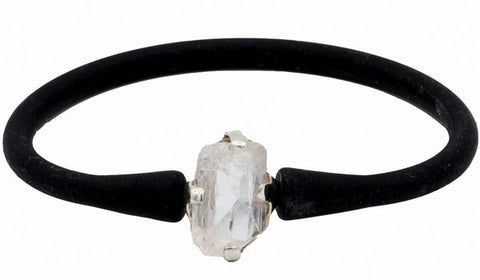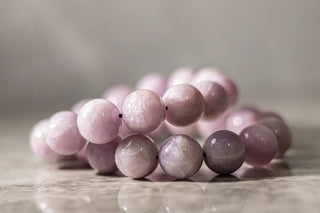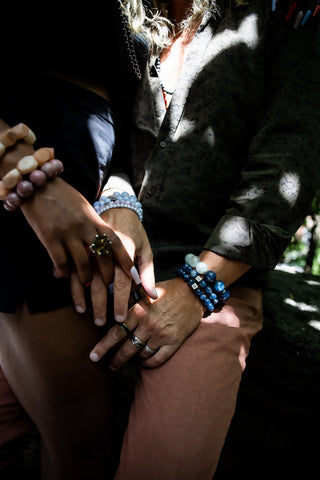From the softest of pastel pink to the richness of lavender pink and purple, kunzite gemstones have been associated with love since their discovery. The kunzite gemstone brings with it a great deal of value and symbolism.
1. What is Kunzite made from in terms of chemical make up?
Kunzite comes in one distinct shade of bubble gum pink. It is very recognizable for its solid coloring and translucent appearance. Its chemical makeup is LiAlSi206. It is ranked on the refractive index between 1.660 and 1.681. Its hardness is around 6.5 and 7 on the Moh’s scale.

Kunzite is quite closely related to pink tourmaline and morganite, two equally popular pink gemstones. What’s more, if you invest in fine jewelry, you should protect it from prolonged exposure to sunlight because the sun can alter the color.
That said, Kunzite is a relatively hard gemstone and yet, it has distinct cleavage which means smacking a piece of Kunzite jewelry against a hard surface or dropping it can result in your pink earrings or ring shattering. It is always best to remove it before sleeping, especially if you are wearing Kunzite earrings or rings. When the time comes to clean your jewelry, use a mild dish soap with warm water to rinse away any dust.
2. Where is Kunzite found?
Kunzite is not found in many places. In fact, the biggest deposits come from Afghanistan and from Brazil in spite of the fact that it was not originally discovered in these larger stores.

3. How long has Kunzite been around?
There are many gemstones with a rich, long history dating back to ancient kings and queens but that is not the case with Kunzite. Kunzite is a relatively young gemstone, first discovered in 1902 in California with small segments found outside of the state of Connecticut a few years prior.
The name “Kunzite” is derived from a famous gem buyer who was employed by Tiffany & Co. named George Frederick Kunz. He was well known for traveling the world and collecting gemstones that were rare and exquisite.
4. Why is Kunzite so expensive?
Kunzite is expensive for a variety of reasons. Firstly, it simply isn't found in many places around the world. The two biggest places include Afghanistan in Brazil, with a few smaller deposits in nearby Pakistan and a handful of other countries. With limited deposits, there is simply an imbalance between supply and demand which raises the price.

Secondly, the color fades with time and as such, finding the most colorful of stones takes work. The rare nature of the deep pink stones means the price is expensive.
5. What determines the price of Kunzite?
The price for kunzite is really based on the shade of pink. The paler the pink shade, the cheaper the kunzite. The more deeply saturated pink the color of the stone, the more expensive it will be. The darker the gemstone, the more expensive it will be.
There are a few other factors that will determine the price of kunzite, like the cut, the size of the gemstone, and the clarity. Kunzite is typically sold in larger sizes so it is rare that you will find a very small stone. That means you will end up paying quite a bit simply because you were paying for a larger stone. On average you can find stones up to eight carats.

How much you pay is also contingent on where you buy your jewelry. If you are purchasing a very pale piece of kunzite, you might pay less than $10 per carat. By comparison if you are paying for an average pink gemstone you might pay $50 per carat but a deeply rich pink stone might cost $180 per carat.
One of the biggest influencers here is the fact that the kunzite gemstone will fade when exposed to sunlight. This means that if you ever wear your kunzite jewelry in the daytime, you will slowly but surely start to diminish its lifespan. The more heat and light it comes into contact with, the more the color will fade with time. This means that as far as Investments are concerned, the deepest shades of pink you can find will still lose their value over time but if you start with a deep pink color it will at least take longer to fade to a light pink color.
Kunzite has earned the nickname of the “evening stone” because of its sensitivity to light, making it the perfect piece of jewelry to wear in the evening or at night.
6. What are the healing benefits of Kunzite?
Kunzite is heavily associated with your heart chakra and your crown chakra. It is known for healing benefits often having to do with love and spiritual peace. For example, many users rely on kunzite to help them achieve unconditional love, to center themselves, to calm nerves, to enhance self-expression, and to cultivate a deep selfless love for everyone. Other healing properties have to do with improving the heart muscle and circulatory system.

7. How to spot fake Kunzite?
If you are looking at kunzite gemstones trying to figure out if they are real or fake, you want to start with the color. A kunzite gemstone is very pink or pinkish Violet in color, but nothing in between. Very rarely will you see a light shade of pink that is kunzite. When you look at the gemstone whether it is set into jewelry or on its own, you should see a very pink color. In fact, most cutters will cut into a kunzite Stone so that the angle on top shows off the brightest, richest pink.
If you are able to, hold the gemstone in your hands, examine it from multiple angles. If, as you move it around you see different colors in the stone, this is more likely to be genuine kunzite.
Why?

Seeing different colors in the stone as you move it around and examine it from different angles is referred to as the pleochroism effect and it is based on the refractive nature of the gemstone. Consider diamonds which look very different and very richly coloured when you examine them at different angles. The reason being, diamonds have a refractive index of 2.417. Kunzite has a refractive index, comparatively, of 1.66 or 1.6 8 so it might not be as colorful from different angles as a diamond but it should still look different as you move it around
8. How is Kunzite different from Rose Quartz?
When it comes to choosing your healing gemstones, you might wonder how kunzite is different from rose quartz. Kunzite is used for stimulating your crown chakra and your heart chakra. This means it might give you high vibrations and spiritual attunement. It is often associated with love because wearing kunzite jewelry has the potential to enable you to feel selfless love, selfless love for who you are and for those around you.

By comparison, rose quartz actually represents healing love to people around you and it helps to heal your higher heart chakra by preventing unwanted thoughts about not getting the love you want or not getting enough of the love you want. Rose quartz really focuses on teaching you to be satisfied with the love that you have and to experience complete happiness while kunzite focuses on helping you to present boundless, selfless love toward yourself and toward those around you.
9. Can raw Kunzite get wet?
Yes, Kunzite can get wet when you wash it. Warm, soapy water is the best recommendation for cleaning your Kunzite jewelry.

That said, some people who turn to gemstones for their healing properties will urge you to clean your stones in salt water instead of regular water to purify or absorb negative energy within the stone, so that you can use its healing properties repeatedly.
However, you should absolutely avoid exposing any raw, rough Kunzite stone to salt water because the salt will damage it.
10. How to find high-quality Kunzite Jewelry
If you are going to purchase kunzite jewelry, it is important that you work only with reputable sources. You don't want to buy from someone who can't provide actionable information about the quality, the transparency, the color, the hardness, or the refractive nature of the stone you are interested in. You can shop safely for kunzite jewelry online or in person. What's most important is that you trust the seller. The seller should be upfront about all of the pertinent details, offer a very flexible exchange policy on the off-chance that the piece of jewelry or gemstone in which you invest doesn't work out, and should have a great deal of information about the stones you are considering.

